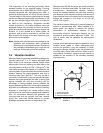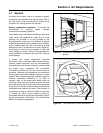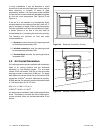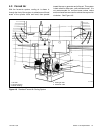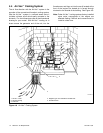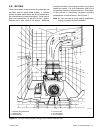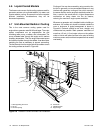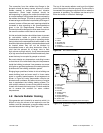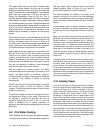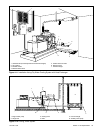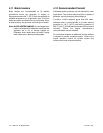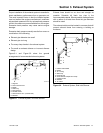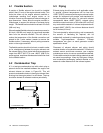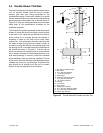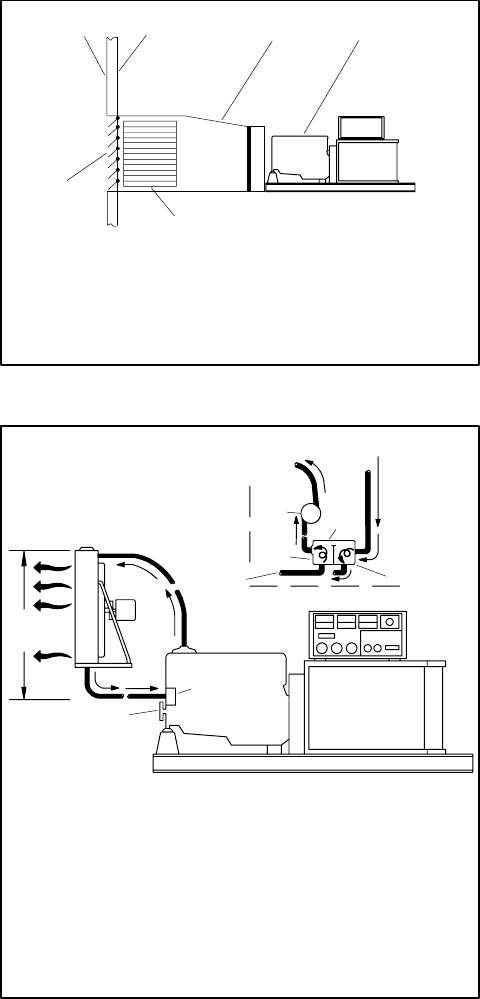
TP-5700 7/93 17Section 4 Air Requirements
The connection from the radiator duct flange to the
ductwork should be heavy canvas, silicone or similar
flexible material to prevent noise and vibration
transmission. Sheet metal ductwork should be
self-supporting. In general, the outlet duct should have
an unrestrictedarea 150%greater thanthat enclosedby
the radiator duct flange. The inlet air opening should be
at leastas large asthe outletbut preferably50% larger.If
screens, louvers or filters are used, openings should be
increased in size according to the recommendations
given in the “Air Requirements, General” section.
Ductwork should be designed toallow ease of service in
the event the radiator would have to be removed.
Air inletand outlet locations shouldbe chosen toprevent
air recirculation inside or outside the enclosure.
Consideration should also be given to prevailing winds,
facing inlets into the expected winds and outlets on the
downwind sidewhere possible. Inletsand outletsshould
be located where they will not be blocked by
accumulated snow or any other obstruction. Keep in
mind that the exhaust air of larger units is both
high-volume and high velocity. It may be accompanied
by a high sound level and should be directed away from
areas that may be occupied by people or animals.
Be sure to design any temperature controlling louvers
so that inlet air is not restricted to the point that pressure
inside the building is reduced. Low pressure can cause
pilot lights on gas fired appliances to be extinguished or
problems with the building ventilation system.
Bringing large quantities of winter air into a building can
waste building heat and even result in frozen water
pipes in normally heated spaces. An arrangement as
shown in Figure 4-9 using thermostatic controls can
eliminate such problems and allow recovery of engine
heat to supplement the building heating system. For
cold outdoor ambients, louvers to the exterior would be
closed, withthose to theinterior open.Controls wouldbe
set to reverse the condition for warm outdoor
temperatures.
4.8 Remote Radiator Cooling
If the generator set is located in an area into which it is
difficult to bring the volume of air required to cool the
radiator, such as a basement, a remote radiator can be
mounted outside the building. See Figure 4-10.
The top of the remote radiator must be at the highest
point in the system to function properly. The fan motor is
connected to the generator output and will run when the
generator is operating. The radiators can be set up for
either horizontal or vertical air discharge.
31 2
5
6
4
TP-5700-4
1. Exterior
2. Interior
3. Air outlet duct
4. Generator set
5. Dampers
6. Controlled air outlet louvers
Figure 4-9 Air Control Louvers
1
2
3
4
5
6
7
8
9
11
10
1. From radiator
2. Cool side
3. Hot well
4. From engine
5. Hot side
6. Auxiliary pump
7. To radiator
8. Remote radiator
9. Engine water pump
10. Suction side
11. Maximum allowable vertical head (varies with engine)
Figure 4-10 Schematic Diagram of Remote Radiator
System



